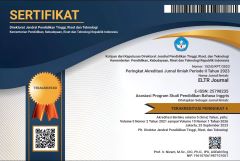METONYMY OF THE WORD ‘INDONESIA’ IN PHRASES ‘PROUD OF INDONESIA’ USED ON FACEBOOK
Abstrak terlihat: 394 / PDF terunduh: 318DOI:
https://doi.org/10.37147/eltr.v3i1.54Keywords:
metonymy, mapping, FacebookAbstract
Simply defined, metonymy is a phenomenon in which two things are associated, so that one thing stands for the other, i.e. the source stands for the target. (Evans and Green, 2006, p. 314; Barcelona, 2003) The example from Evans and Green (2006, p. 312) is “England beat Australia in the 2003 rugby World Cup ?nal.” In that example, England and Australia stand for their own national football teams. The example is whole-for-part metonymy. Generally classified, the types of metonymy are whole for part and part for whole. (Barcelona, 2003, p. 239) What it means by “whole for part” is a general thing represents a specific thing. It goes the other way around for “part for whole”. As everyone uses metonymy very often, it is everyone’s awareness towards metonymy that should be increased. Metonymy is a powerful tool (Guan, 2009, p. 179). It is a “cognitive tool for people’s conceptualization of the world” (Guan, 2009, p. 179) and particularly “for guiding inferencing in the interpretation of spoken discourse” (Kriskovic & Tominac, 2009, p. 50).
Downloads
References
Barcelona, A., Benczes, R., & Ibáñez, F. J. (2011). Introduction. Defining Metonymy in Cognitive Linguistics: Towards a consensus view, 28, 1-6.
Bredin, H. (1984). Metonymy. Poetics Today, 5(1), 45-58.
Clausner, T. C., & Croft, W. (1999). Domains and image schemas. Cognitive Linguistics, 10, 1-32.
Coulson, S., & Oakley, T. (2001). UCSD Cognitive science. Retrieved on 26 Agustus 2014, from Metonymy and Conceptual Blending: http://www.cogsci.ucsd.edu/~coulson/metonymy-new.htm
Croft, W., & Cruse, D. A. (2004). Cognive linguistics. Cambridge: Cambridge University Press.
Crystal, D. (1980). Introduction to language Pathology. London: Arnold/Whurr.
Cutting, J. (2002). Pragmatics and discourse: A resource book of student. London & New York: Routledge.
Djajasudarma, F. (2010). Metode linguistik: Ancangan metode penelitian dan kajian. Bandung: Refika Aditama.
Evans, V., & Green, M. (2006). Cognitive linguistics an introduction. Edinburgh: Edinburgh University Press.
Fu, X. (2012). Metonymy in mind, language, and communication. Wellington: Victoria University of Wellington.
Gärdenfors, P. (1999). Some tenets of cognitive semantics. Cognitive Semantics: Meaning and Cognition, 55, 19-36.
Goossens, L. (2003). Metaphtonymy: The interaction of metaphor. Metaphor and Metonymy in Comparison and Contrast, 20, 349-378.
Guan, J. (2009). The cognitive nature of metonymy and its implications for English vocabulary teaching. Canadian Center of Science and Education, 2(4), 179–183.
Hippel, W. V., & Trivers, R. (2011). The Evolution and psychology of self-deception. Behavioral and Brain Sciences, 34, 1-56.
Ibanez, F. J., & Velasco, O. I. (2003). Patterns of conceptual interaction. Metaphor and Metonymy in Comparison and Contrast, 20, 489-532.
Jakobson, R. (2003). The metaphoric and metonymic Poles. Metaphor and Metonymy in Comparison and Contrast, 20, 41-47.
Kriskovic, A., & Tominac, S. (2009). Metonymy based on cultural background knowledge and pragmatic inferencing: Evidence from spoken discourse. Fluminensia, 21(2), 49–72.
Lakoff, G., & Johnson, M. (1980). Metaphors we live by. Chicago: The University of Chicago Press.
Lynch, M. P. (2009). Deception and the Nature of Truth. The Philosophy of Deception, 188-200.
Mahon, J. E. (2007). A definition of deceiving, International Journal of Applied Philosophy, 21(2), 181-194.
Mahon, J. E. (2008). The Stanford Encyclopedia of Philosophy. Retrieved from The Definition of Lying and Deception: http://plato.stanford.edu/archives/fall2008/entries/lying-definition/
Matlock, T., Ramscar, M., & Boroditsky, L. (2003). The experiential basis of meaning. In Proceedings of the Twenty-fifth Annual Conference of the Cognitive Science Society. Mahwah, NJ: Lawrence Erlbaum.
Nemickien?, Ž. (2011). Concept. In Modern Linguistics: the Component of the Concept “Good”. Periodinis Mokslo Straipsni? Leidinys , pp. 1-11.
Sternberg, R. J., & Mio, J. (2009). Cognitive psychology. CA: Wadsworth, Cengage Learning.
Sugiyono. (2013). Metode penelitian kuantitatif kualitatif dan R&D. Bandung: Penerbit Alfabeta.
Thagard, P. (2012). The Stanford Encyclopedia of Philosophy. Retrieved from Cognitive Science: http://plato.stanford.edu/archives/fall2012/entries/cognitive-science/
Downloads
Published
How to Cite
Issue
Section
License
Copyright (c) 2019 Jennifer

This work is licensed under a Creative Commons Attribution-ShareAlike 4.0 International License.













